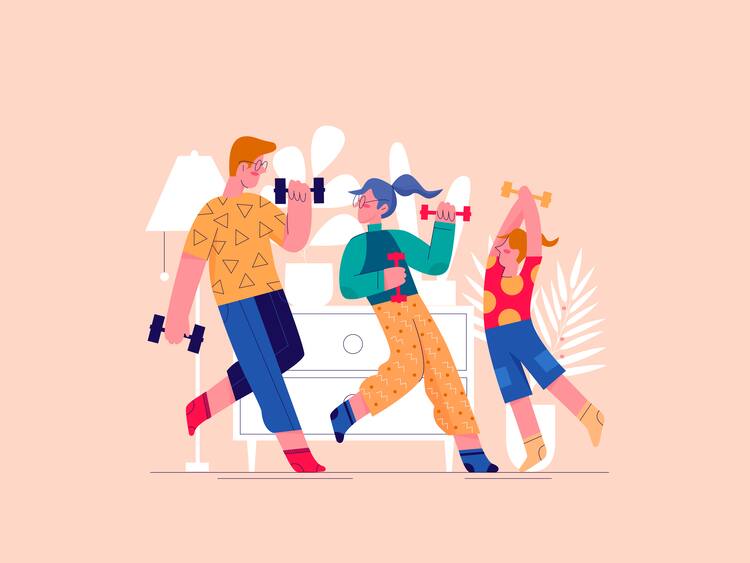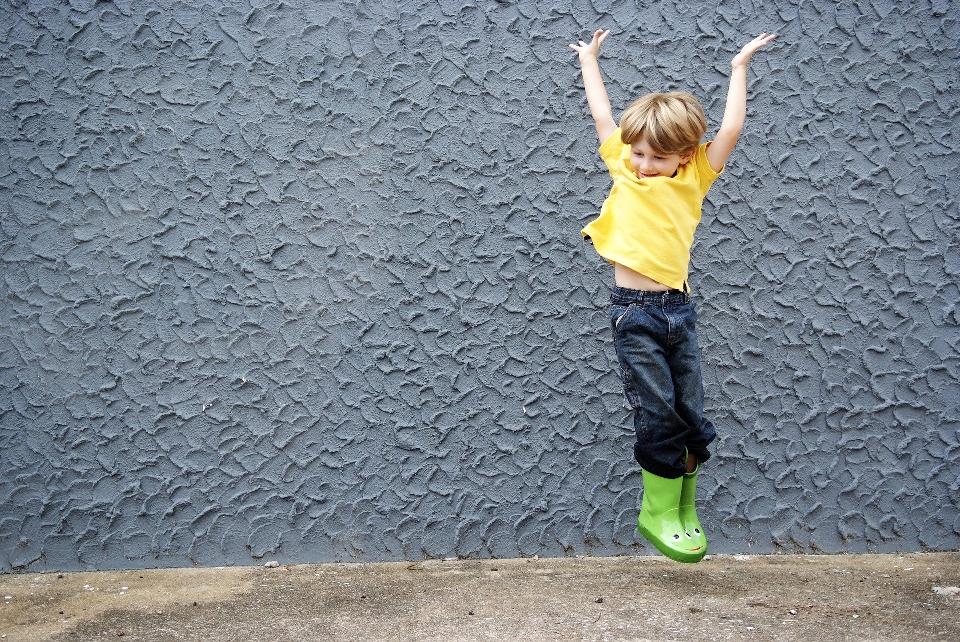By Joanna Pearlstein
Let’s just get this out of the way: Don’t feel guilty. That’s the advice experts offer to parents who are worrying about how to keep their kids fit during the coronavirus pandemic, especially as the days get shorter, the weather begins to cool and options for playing outside diminish. Although the American Academy of Pediatrics recommends that children get at least 60 minutes of activity a day, when recess is canceled and PE is online, that may not be feasible for many families.
“We have to assume everyone’s plate is extremely full, and we have to give parents some grace,” says Hildi Nicksic, clinical assistant professor of kinesiology at Texas A&M University in College Station, Tex. “We understand there’s a lot of pressure, particularly if their children have not returned to school and they’re wearing so many more hats than they usually do.”
The good news: Children are resilient, says Sofiya Alhassan, associate professor and director of the Pediatric Physical Activity Laboratory at the University of Massachusetts at Amherst. “It’s really important not to feel guilty. You have to do what you have to do, without feeling guilty about it.”
That said, physicians say physical activity gives kids energy, reduces body fat, decreases a child’s chances of developing diabetes, and builds muscle, bone, and joint strength, among other benefits. And parents may find that getting their children to move around improves family dynamics. Alhassan, the mom of twin 5-year-olds, notices that her kids tend to argue more when they don’t have outdoor time. “There’s a lot of research to support the impact of physical activity on behavior during non-covid times,” she says. “Kids who are allowed to be physically active during school have better behavior in class, they learn better, they are less hyperactive. Now that we’re stuck inside, there are going to be more mood swings, more arguing.”

Exercise may not only reduce bickering; it can also help with kids’ academic performance. “We know activity is good not only for physical well-being, but also for mental health, focus and attention,” says Korin Hudson, a sports medicine and ER physician who teaches at Georgetown’s medical school and practices in McLean, Va. “For kids with ADHD, activity is really crucial to them in helping keep their focus; staying focused on the screen, where kids are spending so much time, tends to be even harder to maintain.” Most families don’t have access to a playground, but even a few minutes of moving around can be helpful, Hudson says.
Providing opportunities for movement doesn’t have to involve expensive exercise equipment or yet more screen time. Hudson suggests creating a grab jar: Write down exercises — 10 burpees, 20 jumping jacks, holding a plank for 30 seconds, to name a few — on small pieces of paper and put them in a jar. Ask everyone in the family (yes, including parents) to grab a piece of paper and then do the indicated move.
Families that lack outdoor space or aren’t able to take their children outside frequently might turn common household chores into games, says Alhassan. “Ask kids, ‘What can we do to get our energy up? Can you help me fold clothes, then jump really high?’”
Children can also incorporate physical activity directly into their learning. Adrien McDonald, director of athletics and physical education at the McLean School in Potomac, suggests children try shooting baskets while spelling out words. They can do squats at their desk, stretch while reading a book or substitute a one-pound weight for a fidget spinner. (Don’t have a one-pound weight? Try a can of beans.) Another option: Send your children on a scavenger hunt to find items in your house. “It could be, ‘Bring me back something yellow, or bring me back your favorite picture that best describes you,’” McDonald says. Or ask them to race to collect items whose names begin with a certain letter of the alphabet. Then, as a sanity-preservation measure, have a competition to see how quickly they can put all of the found treasures away.

Turning parts of the house into a playground has worked for Danielle and André Bierzynski, who live in the District’s Southwest Waterfront neighborhood with their two daughters, 6 and 2. André has built obstacle courses out of couch cushions for their younger daughter. “Even just walking her up and down the stairs is actually enjoyable for her, and it’s exercise,” he says.
Although their older daughter’s parochial school has resumed in-person instruction, the Bierzynskis have opted to keep her learning at home, which means both parents are working while simultaneously trying to keep their daughters occupied. When they can’t go for walks, the Bierzynskis use yoga videos, a small trampoline and a small basketball hoop to keep the girls moving.
The Bierzynskis’ older daughter also has a fitness tracker that’s designed for children. “It’s become kind of a competition for her; she’s monitoring it herself, and you’ll see her running in circles or up and down the stairs to hit her goals,” says Danielle. She and her husband also have found that their children take notice when they ride their Peloton bike. “The kids know when we are carving out our time for exercise, and it gives them a bit of a jolt. It motivates them,” André says.
Being a role model can not only prompt kids to exercise, but it can also spur them to do things they haven’t tried before. Francine Delgado-Lugo lives in the Brooklyn borough of New York, where she co-owns a personal training gym. After the pandemic began, she and her business partners began making fitness videos for their clients. Delgado-Lugo’s then-9-year-old son, Malachi, was inspired to make his own set of videos, filmed in his mother’s fitness studio, to share with his fellow fourth-graders. “It was a great activity for him,” she says. “He wrote the notes, he narrated the video, and he demonstrated the movements, and I did them alongside him.” Some moves, such as squats and lunges, were things Malachi had seen his mother do at the gym, and others were things he felt kids would want to do. “We found a way to foster creativity and movement together,” Delgado-Lugo says. “It was so much fun.”
It’s crucial to maintain that engagement with kids, says McDonald, the athletic director at the McLean School. “If the kids have buy-in, it makes the pandemic feel a bit easier to manage. When they feel like their voice is being heard, it makes exercise a more enjoyable experience.” After all, if it’s not fun, children may try to opt out, especially in the privacy of their own homes, without the encouragement and company of their peers, and with the “stop video” button beckoning on their laptop or tablet.
In some cases, the development of intrinsic motivation may require some parental help. For example, if a parent wants to take a child hiking, the parent might tell the child she can choose a place to eat lunch afterward, Nicksic says. “The hope is that the kid enjoys themselves, and the next time you ask, they can remember they had a good time last time, and they’ll want to go again. The reason extrinsic motivation is necessary is that if the intrinsic motivation was there, you wouldn’t need to change the behavior, because the individual would have already done it.”

Tips to keep kids moving
- Rubber resistance bands are inexpensive, occupy almost no space and let kids do strength-training moves indoors.
- Attach a retractable net to your dining room table, and presto: table tennis! (Watch out for chandeliers.)
- Replace your kid’s fidget spinner with a one-pound weight or even a can of beans.
- For yoga, families recommend the Cosmic Kids YouTube channel and app.
- An app called Sworkit lets you build your own workout, based on duration and type of exercise; it offers kid-specific options.
- If your child is an extrovert, invite them to make their own fitness video to share with friends.
- Send your kids on a scavenger hunt to find specific types of items in your house. Then, make them race to put it all back.
- Write down exercises on small pieces of paper. Put them in a jar, and let family members choose from the jar. Everyone (yes, everyone) has to do the selected activity.
- Build an obstacle course out of couch cushions or cardboard boxes.
Joanna Pearlstein (@jopearl) is a writer and editor in San Francisco whose work has appeared in WIRED, the New York Times and the COVID Tracking Project.
The information contained in this article is for educational and informational purposes only and is not intended as health or medical advice. Always consult a physician or other qualified health provider regarding any questions you may have about a medical condition or health objectives.





